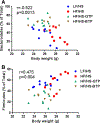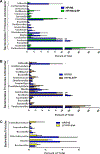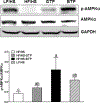Decaffeinated green and black tea polyphenols decrease weight gain and alter microbiome populations and function in diet-induced obese mice
- PMID: 28965248
- PMCID: PMC7367598
- DOI: 10.1007/s00394-017-1542-8
Decaffeinated green and black tea polyphenols decrease weight gain and alter microbiome populations and function in diet-induced obese mice
Abstract
Purpose: Decaffeinated green tea (GT) and black tea (BT) polyphenols inhibit weight gain in mice fed an obesogenic diet. Since the intestinal microflora is an important contributor to obesity, it was the objective of this study to determine whether the intestinal microflora plays a role in the anti-obesogenic effect of GT and BT.
Methods: C57BL/6J mice were fed a high-fat/high-sucrose diet (HF/HS, 32% energy from fat; 25% energy from sucrose) or the same diet supplemented with 0.25% GTP or BTP or a low-fat/high-sucrose (LF/HS, 10.6% energy from fat, 25% energy from sucrose) diet for 4 weeks. Bacterial composition was assessed by MiSeq sequencing of the 16S rRNA gene.
Results: GTP and BTP diets resulted in a decrease of cecum Firmicutes and increase in Bacteroidetes. The relative proportions of Blautia, Bryantella, Collinsella, Lactobacillus, Marvinbryantia, Turicibacter, Barnesiella, and Parabacteroides were significantly correlated with weight loss induced by tea extracts. BTP increased the relative proportion of Pseudobutyrivibrio and intestinal formation of short-chain fatty acids (SCFA) analyzed by gas chromatography. Cecum propionic acid content was significantly correlated with the relative proportion of Pseudobutyrivibrio. GTP and BTP induced a significant increase in hepatic 5'adenosylmonophosphate-activated protein kinase (AMPK) phosphorylation by 70 and 289%, respectively (P < 0.05) determined by Western blot.
Conclusion: In summary, both BTP and GTP induced weight loss in association with alteration of the microbiota and increased hepatic AMPK phosphorylation. We hypothesize that BTP increased pAMPK through increased intestinal SCFA production, while GTPs increased hepatic AMPK through GTP present in the liver.
Keywords: AMPK phosphorylation; Black tea; Green tea; Microflora; Obesity; Polyphenols; Short-chain fatty acids.
Conflict of interest statement
Figures






Similar articles
-
Green tea, black tea, and oolong tea polyphenols reduce visceral fat and inflammation in mice fed high-fat, high-sucrose obesogenic diets.J Nutr. 2014 Sep;144(9):1385-93. doi: 10.3945/jn.114.191007. Epub 2014 Jul 16. J Nutr. 2014. PMID: 25031332
-
Green tea polyphenols decrease weight gain, ameliorate alteration of gut microbiota, and mitigate intestinal inflammation in canines with high-fat-diet-induced obesity.J Nutr Biochem. 2020 Apr;78:108324. doi: 10.1016/j.jnutbio.2019.108324. Epub 2019 Dec 20. J Nutr Biochem. 2020. PMID: 32004926
-
The effect of green tea polyphenols on gut microbial diversity and fat deposition in C57BL/6J HFA mice.Food Funct. 2016 Dec 7;7(12):4956-4966. doi: 10.1039/c6fo01150k. Food Funct. 2016. PMID: 27845787
-
A Review on the Weight-Loss Effects of Oxidized Tea Polyphenols.Molecules. 2018 May 14;23(5):1176. doi: 10.3390/molecules23051176. Molecules. 2018. PMID: 29758009 Free PMC article. Review.
-
The Neuroprotective Effect of Tea Polyphenols on the Regulation of Intestinal Flora.Molecules. 2021 Jun 17;26(12):3692. doi: 10.3390/molecules26123692. Molecules. 2021. PMID: 34204244 Free PMC article. Review.
Cited by
-
Cholecalciferol Supplementation Does Not Prevent the Development of Metabolic Syndrome or Enhance the Beneficial Effects of Omega-3 Fatty Acids in Obese Mice.J Nutr. 2021 May 11;151(5):1175-1189. doi: 10.1093/jn/nxab002. J Nutr. 2021. PMID: 33851198 Free PMC article.
-
Capsaicin Ameliorates High-Fat Diet-Induced Atherosclerosis in ApoE-/- Mice via Remodeling Gut Microbiota.Nutrients. 2022 Oct 17;14(20):4334. doi: 10.3390/nu14204334. Nutrients. 2022. PMID: 36297020 Free PMC article.
-
Tea Polyphenols Attenuates Inflammation via Reducing Lipopolysaccharides Level and Inhibiting TLR4/NF-κB Pathway in Obese Mice.Plant Foods Hum Nutr. 2022 Mar;77(1):105-111. doi: 10.1007/s11130-021-00937-0. Epub 2022 Feb 9. Plant Foods Hum Nutr. 2022. PMID: 35138518
-
Gut microbiota predicts body fat change following a low-energy diet: a PREVIEW intervention study.Genome Med. 2022 May 23;14(1):54. doi: 10.1186/s13073-022-01053-7. Genome Med. 2022. PMID: 35599315 Free PMC article. Clinical Trial.
-
Study of the impact of long-duration space missions at the International Space Station on the astronaut microbiome.Sci Rep. 2019 Jul 9;9(1):9911. doi: 10.1038/s41598-019-46303-8. Sci Rep. 2019. PMID: 31289321 Free PMC article.
References
MeSH terms
Substances
Grants and funding
LinkOut - more resources
Full Text Sources
Other Literature Sources
Medical
Research Materials
Miscellaneous

